Art & Exhibitions
Jean-Léon Gérôme’s Art Epitomized Orientalism. A Major Show in Doha Reconsiders His Legacy
The 400-work exhibition "Seeing Is Believing: The Art and Influence of Gérôme" present broader and more diverse perspectives on the artist, without overlooking the critical scrutiny.
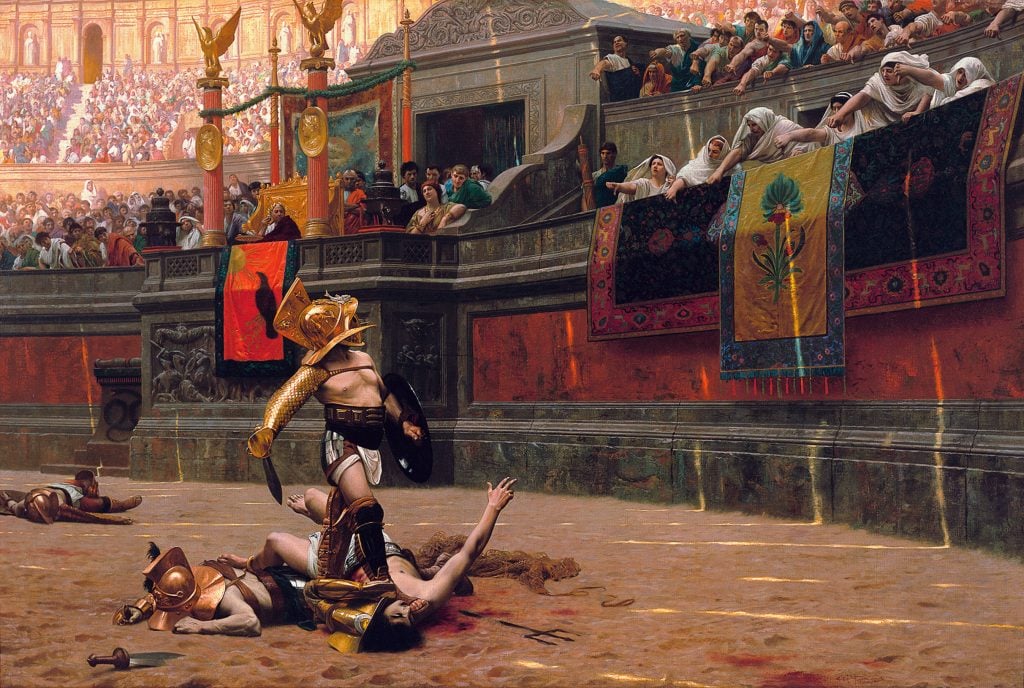
“I know I’m not supposed to because it’s problematic, but I really love Gérôme’s work,” a visitor said sheepishly at the entrance of Mathaf: Arab Museum of Modern Art in Doha ahead of a guided walkthrough of the museum’s newly opened exhibition “Seeing is Believing: The Art and Influence of Gérôme.”
The confession reflects a common sentiment around Jean-Léon Gérôme (1824–1904), a French painter and sculptor whose name and work have become all but synonymous with Orientalism, a term that has been the subject of controversy and interrogation—particularly over the past half-century, but even before. His most recognizable painting today, the 1872 painting Pollice Verso (Thumbs Down), which was famously a source of inspiration for Ridley Scott’s 2000 film Gladiator, initially sparked debate when it premiered as scholars disputed whether the thumbs down gesture in gladiatorial combat was historically accurate.
The controversial concept of Orientalism, and its impact on history both real and perceived, is also the keystone theme of “Seeing is Believing,” which seeks to expand the framework through which Gérôme and Orientalist art are considered, inclusive (perhaps most importantly) of non-Western perspectives.
The significance of the show is underscored by the fact that 2024 marks the 200th anniversary of Gérôme’s birth, and the Lusail and Mathaf museums are the only Arab institutions showcasing his art for this bicentennial, a testament to the museums’ innovative approach to Orientalism, past and present.
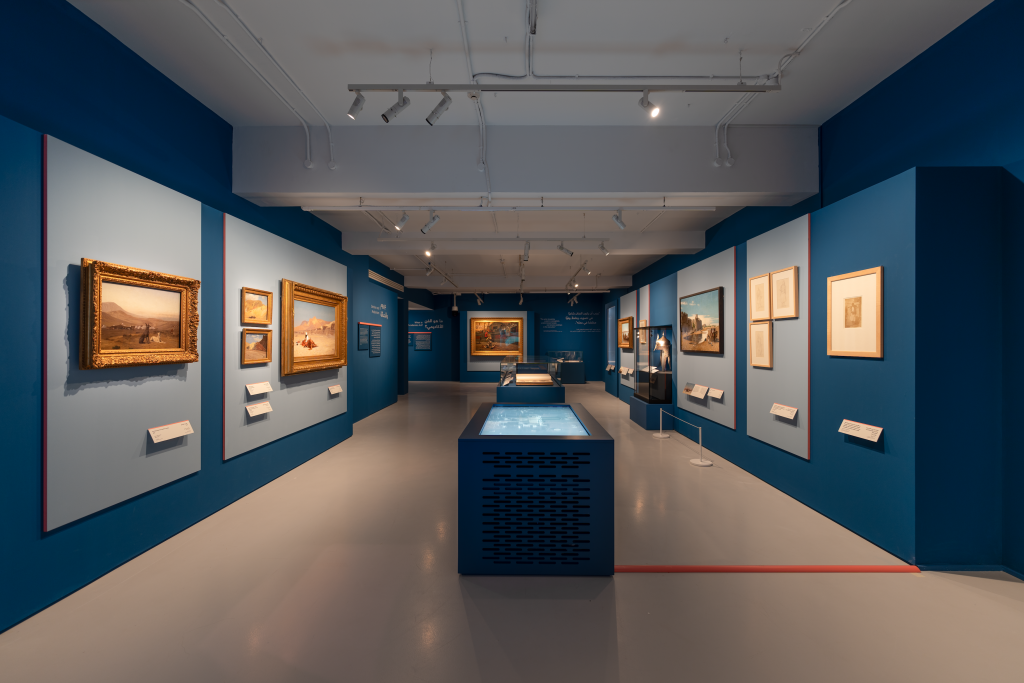
Installation view of “Seeing is Believing: The Art and Influence of Gérôme” (2024). Courtesy of MATHAF: Arab Museum of Modern Art and Lusail Museum, Doha.
The major exhibition was organized by the future Lusail Museum in collaboration with and presented at Mathaf. The Lusail Museum, in the process of being fully realized on the north side of Doha in a monumental, circular building designed by Swiss architectural firm Herzog & de Meuron, already boasts one of the world’s largest collections of Orientalist art. Many of the expansive show’s 400-plus works are drawn from this collection, alongside major international loans from institutions such as the Metropolitan Museum of Art, New York, and the Islamic Arts Museum, Malaysia, as well as a range of new, specially commissioned works by contemporary artists.
“Seeing is Believing” is divided into three distinct parts, each separately curated by Lusail Museum guest curator Emily Weeks, Lusail Museum curator of photographs Giles Hudson, and Mathaf guest curator Sara Raza, respectively. The opening section and focus herein, entitled “A Wider Lens, A New Gérôme” offers a sweeping survey of the man himself, his oeuvre, and the well-known problematic aspects—as referenced by the reluctant fan at the opening of the show—of his work and legacy.
The Art Star of Orientalism
Gérôme’s lavish Orientalist paintings became wildly popular, his depictions not only of resplendent courts, harems, and mosques but “snapshot” compositions of everyday interiors and peoples captured the world’s attention, catapulting him to a level of fame at the time that cannot be understated.
“Gérôme was the most influential, marketable, marketed, and successful artist in 19th-century France,” said Weeks in a walkthrough of the exhibition. “His reputation was international, his prestige and his fame also became incredibly great throughout America and Britain, more broadly throughout Europe, even Japan and Russia. He was known worldwide, mostly for his Oriental works. What that means is that his visions, his creations shaped a worldview. It shaped people’s perceptions of the MENASA region—Middle East, North Africa, South Asia.”
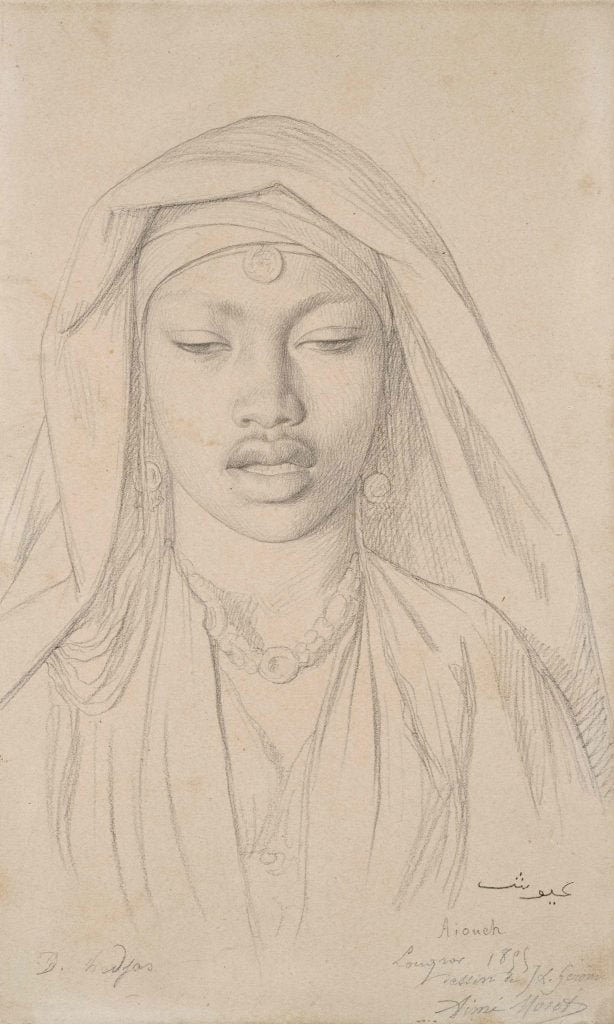
Jean-Léon Gérôme, Portrait of a Woman (Aiouch) (ca. 1855–1856. Courtesy of Colnaghi Elliott Master Drawings.
Born in Vesoul, France, Gérôme was trained in the academic tradition under artists such as Paul Delaroche and Charles Gleyre, as well as at the École des Beaux-Arts. Academic art, or academicism, is a style of art that was initially taught and promoted by the formal art academies of Europe (with the École des Beaux-Arts arguably at the forefront), which adhered to classical ideals and techniques; while there are numerous tenets to the style, highly polished brushwork, romanization, and the inclusion of narrative, even theatrical content are some of the elements that stand out in the tradition.
In the mid-to-late 1840s, Gérôme’s career took off, seeing him win third place at the 1847 Paris Salon and shortly thereafter garnering favor from French critic Théophile Gautier. And while he received increased local attention, his foray into Orientalist painting is arguably what landed him in the history books.
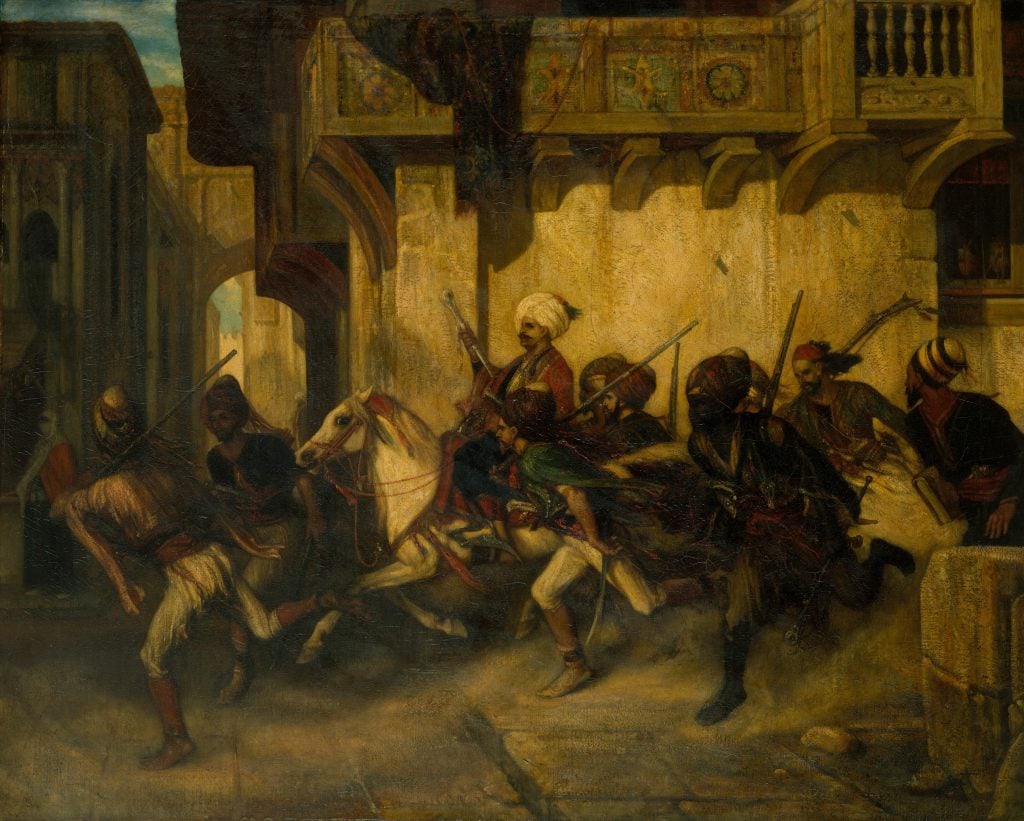
Alexandre Gabriel Decamps, The Turkish Patrol (ca. 1855–56). Collection of the Metropolitan Museum of Art.
Gérôme visited Egypt for the first time in 1856, heralding the beginning of a life marked by extensive travel, returning multiple times to Cairo and the surrounding areas as well as various locales across the region. Photos included within “Seeing is Believing” emphasize his physical presence there, replete with candid images of Gérôme on a donkey, or seated on the desert landscape. He became so invested in the area that at one point, following a visit to the Ottoman Palace, he not only sold his work there but also became the curator and buyer of the collection (a prototype of the contemporary art advisor?).
Coupled with his earlier travels to Italy as part of his artistic training, Gérôme began to craft a vision of the region, one that tapped the idealized realism of academic painting, the monumentality of Roman art and architecture, and reflected his ardor for the environments and cultures he encountered—cherry picking objects, landscapes, garb, and designs from across time and place and mixing them into his own visual creations.
What is important to note, as it is in the exhibition, is that Gérôme’s work and career essentially evolved in step with the then-emergent medium of photography. Using similar framing techniques as well as photorealistic rendering, Gérôme’s paintings visually argued for their own “realness,” but were instead carefully crafted fantasies, where the boundary between reality and fiction was meticulously blurred.
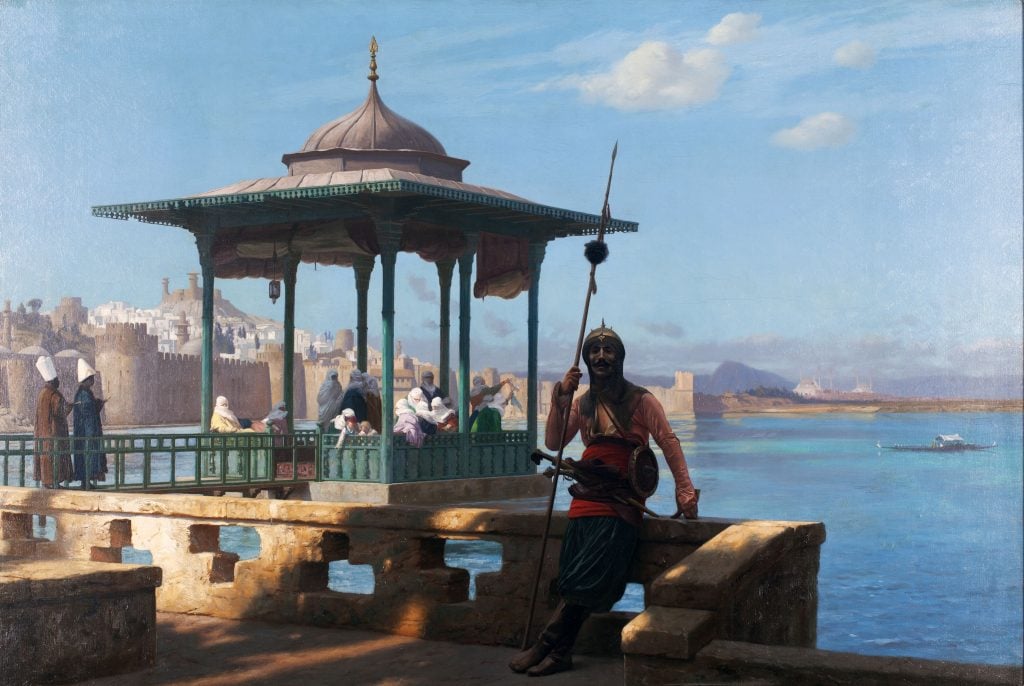
Jean-Léon Gérôme, The Harem in the Kiosk (1870–1875). Courtesy of Lusail Museum, Qatar Museums, Doha.
The Enduring (and Less-Talked-About) Influence of Gérôme
Today, Gérôme’s work is considered the epitome of traditional, a designation that was creeping in even by the turn of the 20th century; in the twilight of his otherwise dazzling career, his work was increasingly thought of as antiquated, exemplary of academic painting, which slowly seeped popularity with the rise of Modernism. Because of this, little critical attention has been paid to the ways in which, at his height, Gérôme was in fact one of the most innovative artists to emerge in his time.
This is perhaps no more apparent than a close analysis of the artist’s application of color, which is highlighted in the show through never-before-done x-rays of his paintings, which a video display showcases. In a depiction of the Sinai Dessert, which at first glance coalesces into the expected beigey browns, one can see on closer inspection a range of pastels, reds and purples, pinks and blues. “The more you look, the more colors you see,” said Weeks. “This is Gérôme’s attempt at representing what the eye sees in direct sunlight—and what is this? This is the curiosity of the Impressionists. It is no accident that Mary Cassatt was a student of his. The Impressionists understood what [he] was doing.”
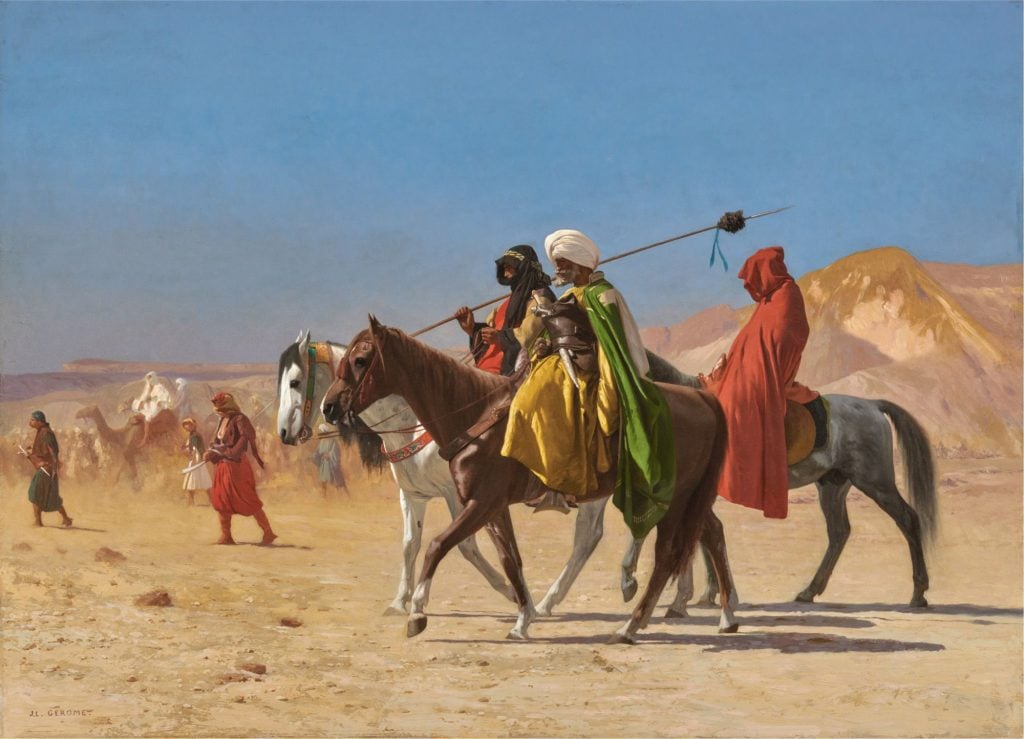
Jean-Léon Gérôme, Riders Crossing the Desert (1870). Courtesy of the Islamic Arts Museum, Malaysia.
Beyond his pioneering explorations in opticality, a nascent form of symbolism, can be read in his work. Mining color not only for its visual potential, he also began using it for its ability to convey emotion, even drama. The highly saturated hues that are now synonymous with Orientalist painting originated from Gérôme’s experiments, foreshadowing the greater move toward symbolism as a movement. (It is also no surprise then that Symbolist painter Odilon Redon was also one of his students).
“You may think his style is traditional, conservative, maybe even old-fashioned. Why? Because it’s so intensely realistic,” said Weeks. “This is not Modernism; this is not abstraction. My claim is that Gérôme was not an Impressionist. Of course, he’s not a Symbolist. He’s not avant-garde, but within the process of an academic technique, he was pushing every envelope, every boundary, and the mindset behind this is progressive and modern.”
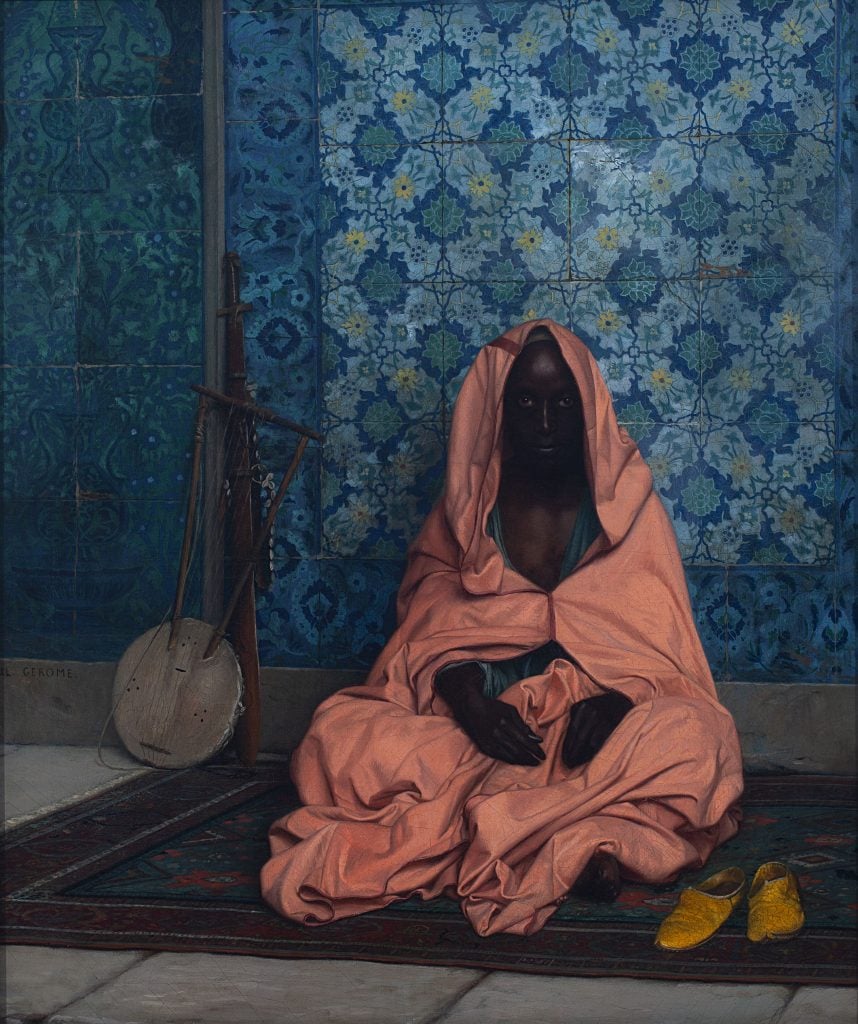
Jean-Léon Gérôme, The Black Bard (1888). Courtesy of Lusail Museum, Qatar Museums, Doha.
The breadth and scope of Gérôme’s reputation and legacy can be attributed in no small part to his prolific teaching, extended far beyond the few most famous students like Cassatt and Redon. In 1864, he was appointed as a professor at the École des Beaux-Arts, and between his first class and his last in 1904, over 2,000 students, including women, received his tutelage.
“I would argue that every Orientalist work that was created after Gérôme bears his handprint,” said Weeks. “He was that important. That influential.”
Orientalism and the Period Eye
While the etymology of the term Orientalism can be traced to Medieval times, its use and meaning in contemporary discourse was popularized by academic and literary critic Edward Said in 1978 with his book Orientalism. Said’s writings expanded and established the term not only as one to broadly describe the study of and attention to “the East” from a Western perspective, but a political concept inextricably entwined with Western imperialism, fetishization, and contemptuous views and attitudes toward the c region. On the cover of Said’s book is none other than a reproduction of one of Gérôme’s paintings, The Snake Charmer (1880).
Said’s writing was ultimately followed a few years later by art historian Linda Nochlin with her 1983 essay The Imaginary Orient, published in Art in America, where she levels the politicization and issues surrounding Orientalism more squarely within an art historical context, arguing that the power structures and dynamics from which a work of art or artist emerges is imperative to critical assessment.
“Seeing is Believing” does not shy away from the politicization the term engenders within contemporary interpretations of Gérôme’s oeuvre, going so far as to feature a copy of Said’s Orientalism as part of the exhibit. Frankly, it perhaps wouldn’t have been possible to sidestep the inclusion as the release of the book launched both Gérôme’s work and the genre of Orientalist art back into the mainstream consciousness of the 20th century, rendering it the subject of fervent and ongoing debate (and, in some cases, embarrassment for those who enjoy his work).
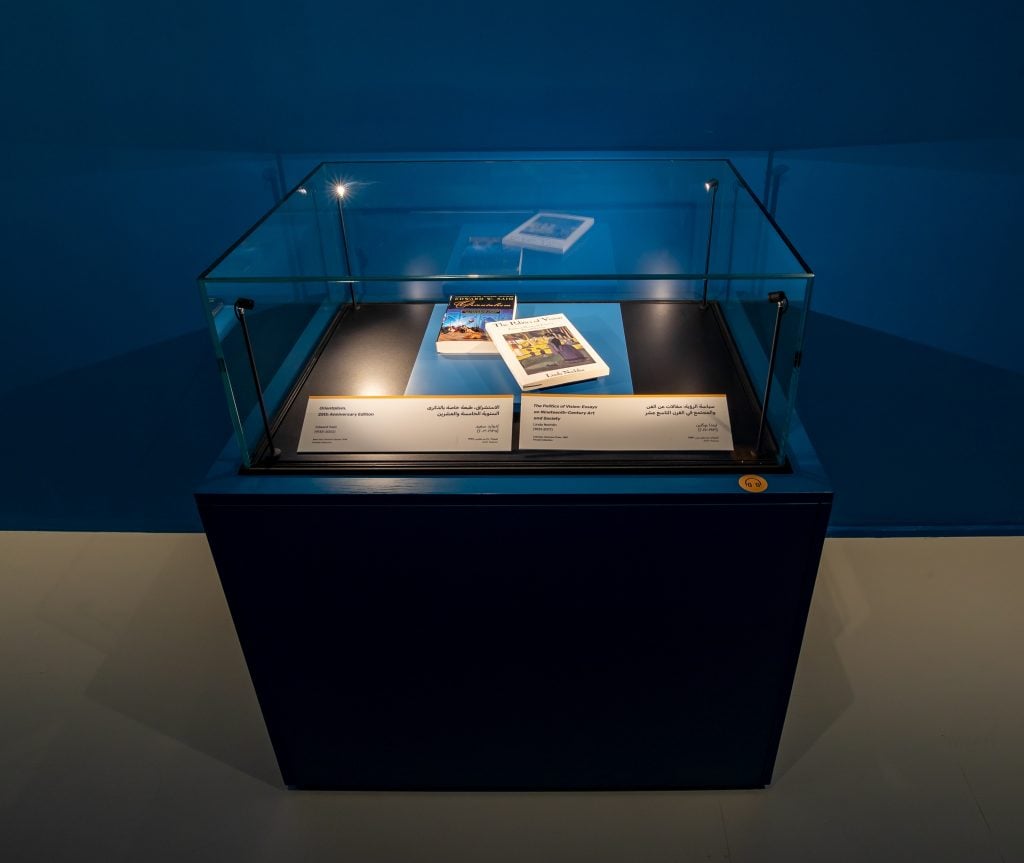
Vitrine containing the anniversary edition of Edward Said, Orientalism (1994) and Linda Nochlin, The Politics of Visions: Essays on Nineteenth-Century Art and Society (1989). Courtesy of MATHAF: Arab Museum of Modern Art and Lusail Museum, Doha.
Though not a specific term proposed within “Seeing is Believing,” the “Period Eye” could be considered an apt description of the show’s strategy. Coined by art historian Michael Baxandall in 1972, it is an approach to art history that refers to the broader cultural and social environment within which an artwork was made and the manner it would have, at the time of creation, been viewed. While contemporary discourse around Gérôme and Orientalism are today largely bound by political interpretation, it wasn’t always so. The exhibition not only contextualizes the time and place these works were made but offers insight into the evolution of their reception. For instance, the term Orientalist was not then new, but it had a starkly shallower definition and connotation to that of today: “In the 19th century, it was simple: Non-indigenous artist representations of the MENASA region. Full stop. Period. That was Orientalism.”

Jean-Léon Gérôme, Veiled Circassian Lady (1876). Courtesy of Lusail Museum, Qatar Museums, Doha.
Herein lies the primary strength of “A Wider Lens, A New Gérôme”: its comprehensiveness without being prescriptive, no doubt speaking to the show’s intended audience, those of the MENASA region. The show makes no attempt to jump into this specific fray—or any one in particular for that matter. Rather, it presents a comprehensive range—from contentious to comparatively mundane—perspectives and histories together in an attempt to craft a more holistic account of the artist and his oeuvre, leaving ultimate judgment up to the viewer, with the only appeal to the viewer being for an openness to holding more than one thing true at once, rather than dismiss reassessments of any kind as pure apologia.
It is interesting to consider how this approach may have differed had this show been staged in a Western museum to a predominantly Western audience, the same audience Gérôme historically geared his work toward. Here, in Doha, with the subject matter being that of the greater regional peoples and culture, the judgment or lack thereof, fittingly leaves room for the lived experience and histories the assumed regional visitors bring to it; a certain degree of explanation or didacticism is rendered redundant.
In an anecdote around one of Gérôme’s paintings of Cairo, Weeks, who lived in the city for 16 years, noted she couldn’t say where the landmarks in the work were because they did not actually exist. Similarly, visitors familiar with his supposed subjects and places would too recognize immediately the discrepancies. Through this lens, the presentation of “Seeing is Believing: The Art and Influence of Gérôme” at Mathaf itself speaks to a form of reclamation, one in which the roiling debate around Orientalism and the artist who championed it firmly placed within the appropriate context, for MENASA audiences rather than about them.





